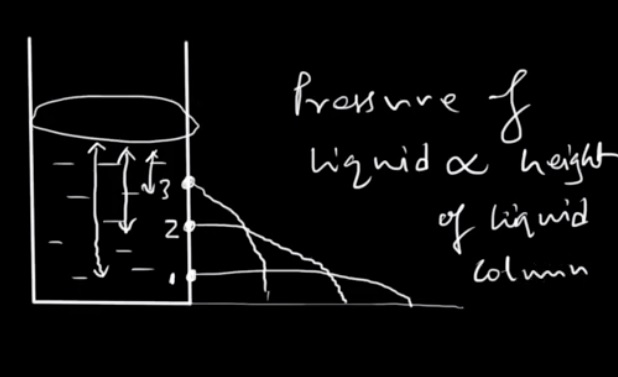

Liquid pressure refers to the force exerted by a liquid on the walls of its container or any other object immersed in it. It arises due to the weight of the liquid pushing down on the underlying surface. The deeper the liquid, the greater the pressure it exerts.
Factors Affecting Liquid Pressure: There are several factors that influence the magnitude of liquid pressure:
Depth: The depth of the liquid is a crucial factor in determining the pressure it exerts. The greater the depth, the higher the pressure due to the increased weight of the liquid above.
Density: The density of the liquid also plays a role in liquid pressure. Liquids with higher densities exert greater pressure compared to those with lower densities, given the same depth.
Gravitational Acceleration: The acceleration due to gravity affects liquid pressure. On Earth, where the acceleration due to gravity is relatively constant, it contributes to the weight of the liquid and consequently affects the pressure it exerts.
Let's consider three different scenarios with holes positioned at various levels of a jar: near the top, in the middle, and near the bottom.

Hole near the top: If the hole is located near the top of the jar, where the liquid column above it is relatively small, the liquid stream that gushes out will fall closer to the jar. This is because the pressure exerted by the liquid is lower at this height, resulting in a less forceful flow. The liquid will likely flow out in a shorter stream and descend closer to the jar.
Hole in the middle: When the hole is positioned in the middle of the jar, the liquid column above it is larger compared to the top hole scenario. As a result, the pressure at this level is higher, leading to a more forceful flow. The liquid stream that emerges from the hole will travel a greater distance before falling down. The increased pressure contributes to a stronger and more extended stream.
Hole near the bottom: If the hole is near the bottom of the jar, where the liquid column above it is at its maximum, the pressure exerted by the liquid is significantly greater. As a result, the liquid will be pushed out with a stronger force, and the stream will cover a larger distance before falling down. The pressure is highest near the bottom due to the weight of the entire liquid column above it, resulting in a more vigorous and far-reaching flow.
Pascal's Law and Liquid Pressure: Pascal's law states that when pressure is applied to a confined fluid, it is transmitted equally in all directions. This principle helps us understand how liquid pressure is distributed within a fluid and how it can be harnessed for various applications.
Practical Applications of Liquid Pressure: Understanding liquid pressure is essential in various practical scenarios. Here are a few examples:
Hydraulic Systems: Hydraulic systems rely on liquid pressure to transmit force and accomplish tasks. For instance, hydraulic brakes in vehicles use liquid pressure to amplify the force applied to the brake pedal, resulting in effective braking.
Diving: Divers experience increasing pressure as they descend into deeper waters. Understanding liquid pressure is crucial for ensuring diver safety and avoiding complications such as decompression sickness.
Water Supply Systems: Liquid pressure plays a vital role in water supply systems, ensuring that water is delivered to higher floors in buildings. It allows water to reach the desired locations through pipes and faucets.
